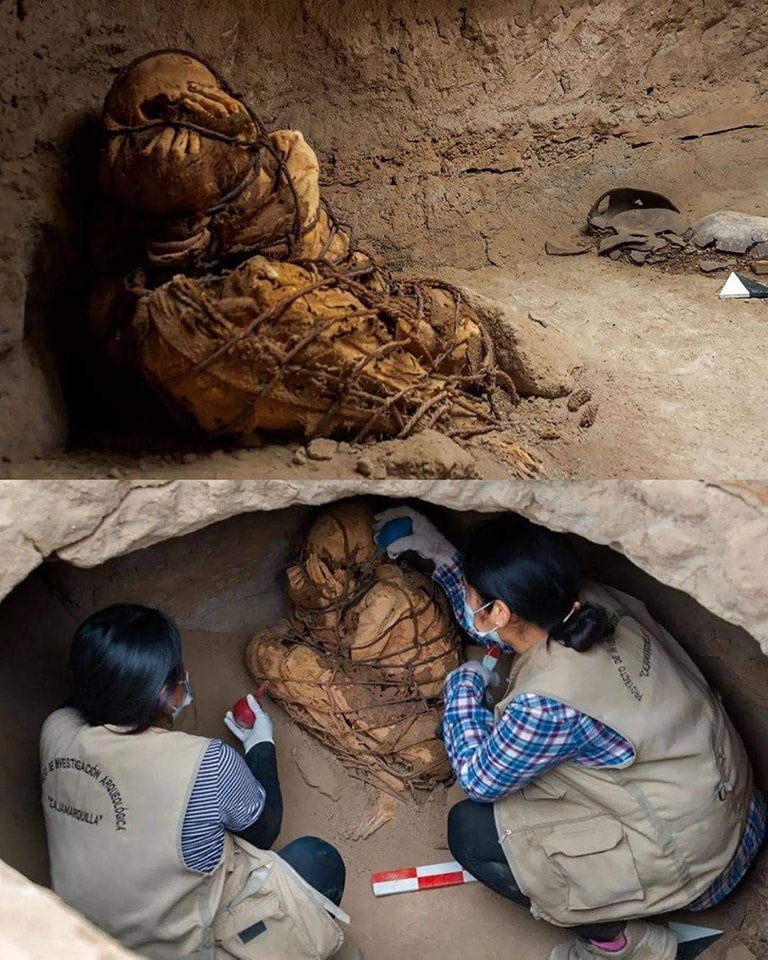Deep in the heart of Peru, only 16 miles from the vibrant city of Lima, lies a portal to the ancient past. At the Cajamarquilla archaeological site, a team of researchers from California State University San Marcos has made a discovery that has captivated the scientific community. They have unearthed a mummy that reshapes our understanding of ancient funeral traditions and offers a rare glimpse into a civilization long forgotten.

The Mummy That Holds Silent Secrets
The mummy, bound tightly with ropes and positioned with its hands covering its face, presents an eerie yet profound snapshot of ancient burial practices. This mysterious figure, estimated to be between 800 and 1,200 years old, likely belonged to a young man no older than 22 when he passed away. His body was found resting partially on its side, nestled against rocks and the wall of his underground tomb, in a position that speaks volumes about the ceremonial rites and traditions of his time. This silent figure, preserved for centuries, is a powerful testament to the reverence with which the dead were treated in this ancient culture.
A Tomb Overflowing with History
The discovery of the mummy was not an isolated event. Under the leadership of Professor Pieter Van Dalen Luna, the excavation team uncovered an array of funerary artifacts that shed light on the customs and practices of the civilization. The tomb contained stone tools, ceramic pots with remnants of plant material, and the remains of a dog and a guinea pig, which may have held symbolic or practical significance. Just outside the tomb, mollusk shells and llama bones suggest that mourners visited the site, bringing food offerings to honor their deceased loved one. These items, carefully arranged and preserved, paint a vivid picture of the rituals that surrounded death in this society.
Unveiling the Layers of Peru’s Past
Cajamarquilla is more than just an archaeological site; it is a gateway to understanding the rich and diverse cultures that thrived in Peru long before the rise of the Inca Empire. The pre-Incan civilizations that inhabited the region left behind a complex legacy, and discoveries like this mummy help illuminate the intricate tapestry of their lives. The site serves as a melting pot of cultural and historical significance, offering a glimpse into a time when Peru’s coastal and mountainous regions were home to thriving communities with unique traditions.
Peru’s Landscape as a Living Museum
Peru is often referred to as a living museum, a land where ancient history coexists with the present. Its landscape is dotted with archaeological sites that reveal the stories of civilizations that predate the Inca. The Inca Empire, which rose to prominence in the early 13th century, extended its influence across South America until the Spanish conquistadors arrived in the 16th century. However, as the discovery at Cajamarquilla demonstrates, Peru’s history is far more nuanced and complex than the story of the Inca alone. These earlier civilizations contributed significantly to the cultural and historical fabric of the region, leaving behind artifacts and structures that continue to intrigue modern scientists and historians.
The Importance of Radiocarbon Dating
One of the next steps for scientists studying this mummy is the use of radiocarbon dating to determine more precise details about its age and context. This advanced scientific technique will help researchers unlock further secrets about the life and times of this individual and the society to which he belonged. Each new piece of information adds another layer to our understanding of Peru’s ancient history, revealing a past that is as intricate as it is fascinating.
Cajamarquilla: A Treasure Trove of Knowledge
The Cajamarquilla site continues to be a focal point for archaeological exploration, offering invaluable insights into the lives of pre-Incan peoples. The diversity of artifacts and burial practices discovered there reflects the complexity of the civilizations that once thrived in this region. From the tools and ceramics used in daily life to the symbolic offerings left for the dead, every detail contributes to a broader understanding of how these communities lived, worked, and honored their ancestors.
A Deeper Connection to the Past
Discoveries like the mummy at Cajamarquilla remind us of the profound connection between the past and the present. They challenge us to look beyond the dominant narratives of history, such as the rise and fall of empires, to appreciate the smaller, yet equally significant, stories of the people who lived, loved, and died in these ancient societies. These findings also underscore the importance of preserving and studying archaeological sites, as they hold the keys to unlocking mysteries that have remained hidden for centuries.
The Unfinished Story of Cajamarquilla
As scientists and archaeologists continue their work at Cajamarquilla, one thing is certain: the site still has many stories to tell. Each discovery, no matter how small, contributes to a more comprehensive understanding of the diverse cultures that shaped Peru’s history long before the Inca came to power. This ancient mummy, with its tightly bound ropes and hauntingly serene posture, serves as a poignant reminder of the complexity and richness of Peru’s past.
In the sands of Cajamarquilla, the echoes of ancient voices remain. Through meticulous research and exploration, these voices are being brought back to life, allowing us to glimpse a world that existed long before our own. It is a journey through time, a rediscovery of forgotten civilizations, and a testament to the enduring power of human curiosity and resilience. As we uncover the secrets of sites like Cajamarquilla, we not only learn about the past but also gain a deeper appreciation for the enduring legacy of humanity itself.





